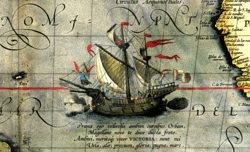Ferdinand Magellan
Ferdinand Magellan (/məˈɡɛlən/[1] or /məˈdʒɛlən/;[2] Portuguese: Fernão de Magalhães, IPA: [fɨɾˈnɐ̃w dɨ mɐɣɐˈʎɐ̃jʃ]; Spanish: Fernando de Magallanes, IPA: [feɾˈnando ðe maɣaˈʎanes]; c. 1480 – 27 April 1521) was a Portuguese explorer who organised the Spanish expedition to the East Indies from 1519 to 1522, resulting in the first circumnavigation of the Earth, which was completed by Juan Sebastián Elcano.
Ferdinand Magellan | |
|---|---|
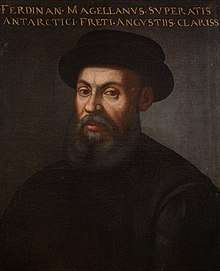 Ferdinand Magellan, in a 16/17th century anonymous portrait | |
| Born | Fernão de Magalhães c. 1480 |
| Died | 27 April 1521 (aged ≈41) |
| Nationality | Portuguese |
| Known for | The first circumnavigation of the Earth |
| Signature | |
 | |
Born around 1480 into a family of minor Portuguese nobility, Magellan became a skilled sailor and naval officer and was in service of the Portuguese crown in Asia. After King Manuel I of Portugal refused to support his plan to reach India by a new route, by sailing around the southern end of the South American continent, he was eventually selected by King Charles I of Spain to search for a westward route to the Maluku Islands (the "Spice Islands"). Commanding a fleet of five vessels, he headed south through the Atlantic Ocean to Patagonia. Despite a series of storms and mutinies, they made it through the Strait of Magellan into a body of water he named the "peaceful sea" (the modern Pacific Ocean).[3] The expedition reached the Philippine islands, where Magellan was killed during the Battle of Mactan. The expedition later reached the Spice Islands in 1521 and one of the surviving ships eventually returned home via the Indian Ocean, completing the first circuit of the globe.
Magellan had already reached the Malay Archipelago in Southeast Asia on previous voyages traveling east (from 1505 to 1511–1512). By visiting this area again but now travelling west, Magellan achieved a nearly complete personal circumnavigation of the globe for the first time in history.[4][5]
Early life and travels
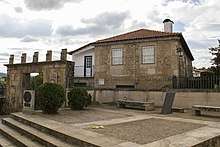
Magellan was born in the Portuguese town of Sabrosa in or around 1480.[6] His father, Pedro de Magalhães, was a minor member of Portuguese nobility[6] and mayor of the town. His mother was Alda de Mezquita.[7] Magellan's siblings included Diego de Sosa and Isabel Magellan.[8] He was brought up as a page of Queen Eleanor, consort of King John II. In 1495 he entered the service of Manuel I, John's successor.[9]
In March 1505 at the age of 25, Magellan enlisted in the fleet of 22 ships sent to host Francisco de Almeida as the first viceroy of Portuguese India. Although his name does not appear in the chronicles, it is known that he remained there eight years, in Goa, Cochin and Quilon. He participated in several battles, including the battle of Cannanore in 1506, where he was wounded. In 1509 he fought in the battle of Diu.[10]
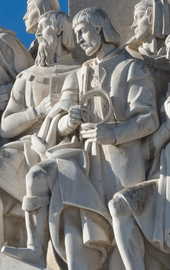
He later sailed under Diogo Lopes de Sequeira in the first Portuguese embassy to Malacca, with Francisco Serrão, his friend and possibly cousin.[11] In September, after arriving at Malacca, the expedition fell victim to a conspiracy ending in retreat. Magellan had a crucial role, warning Sequeira and risking his life to rescue Francisco Serrão and others who had landed.[12][13]
In 1511, under the new governor Afonso de Albuquerque, Magellan and Serrão participated in the conquest of Malacca. After the conquest their ways parted: Magellan was promoted, with a rich plunder and, in the company of a Malay he had indentured and baptized, Enrique of Malacca, he returned to Portugal in 1512 or 1513.[14] Serrão departed in the first expedition sent to find the "Spice Islands" in the Moluccas, where he remained. He married a woman from Amboina and became a military advisor to the Sultan of Ternate, Bayan Sirrullah. His letters to Magellan would prove decisive, giving information about the spice-producing territories.[15][16]
After taking a leave without permission, Magellan fell out of favour. Serving in Morocco, he was wounded, resulting in a permanent limp. He was accused of trading illegally with the Moors. The accusations were proven false, but he received no further offers of employment after 15 May 1514. Later on in 1515, he got an employment offer as a crew member on a Portuguese ship, but rejected this. In 1517 after a quarrel with King Manuel I, who denied his persistent demands to lead an expedition to reach the spice islands from the east (i.e., while sailing westwards, seeking to avoid the need to sail around the tip of Africa[17]), he was allowed to leave for Spain. In Seville he befriended his countryman Diogo Barbosa and soon married the daughter of Diogo's second wife, Maria Caldera Beatriz Barbosa.[18] They had two children: Rodrigo de Magalhães[19] and Carlos de Magalhães, both of whom died at a young age. His wife died in Seville around 1521.
Meanwhile, Magellan devoted himself to studying the most recent charts, investigating, in partnership with cosmographer Rui Faleiro, a gateway from the Atlantic to the South Pacific and the possibility of the Moluccas being Spanish according to the demarcation of the Treaty of Tordesillas.
Voyage of circumnavigation
Background and preparations
After having his proposed expeditions to the Spice Islands repeatedly rejected by King Manuel of Portugal, Magellan turned to Charles I, the young King of Spain (and future Holy Roman Emperor). Under the 1494 Treaty of Tordesillas, Portugal controlled the eastern routes to Asia that went around Africa. Magellan instead proposed reaching the Spice Islands by a western route, a feat which had never been accomplished. Hoping that this would yield a commercially useful trade route for Spain, Charles approved the expedition, and provided most of the funding.
Magellan's fleet consisted of five ships, carrying supplies for two years of travel. The crew consisted of about 270 men.[20] Most were Spanish, but around 40 were Portuguese.[21]
Voyage
The fleet left Spain on 20 September 1519, sailing west across the Atlantic toward South America. In December, they made landfall at Rio de Janeiro. From there, they sailed south along the coast, searching for a way through or around the continent. After three months of searching (including a false start in the estuary of Río de la Plata), weather conditions forced the fleet to stop their search to wait out the winter. They found a sheltered natural harbor at the port of Saint Julian, and remained there for five months. Shortly after landing at St. Julian, there was a mutiny attempt led by the Spanish captains Juan de Cartagena, Gaspar de Quesada and Luis de Mendoza. Magellan barely managed to quell the mutiny, despite at one point losing control of three of his five ships to the mutineers. Mendoza was killed during the conflict, and Magellan sentenced Quesada and Cartagena to being beheaded and marooned, respectively. Lower-level conspirators were made to do hard labor in chains over the winter, but later freed.
During the winter, one of the fleet's ships, the Santiago, was lost in a storm while surveying nearby waters, though no men were killed. Following the winter, the fleet resumed their search for a passage to the Pacific in October 1520. Three days later, they found a bay which eventually led them to a strait, now known as the Strait of Magellan, which allowed them passage through to the Pacific. While exploring the strait, one of the remaining four ships, the San Antonio, deserted the fleet, returning east to Spain. The fleet reached the Pacific by the end of November 1520. Based on the incomplete understanding of world geography at the time, Magellan expected a short journey to Asia, perhaps taking as little as three or four days.[22] In fact, the Pacific crossing took three months and twenty days. The long journey exhausted their supply of food and water, and around 30 men died, mostly of scurvy.[23] Magellan himself remained healthy, perhaps because of his personal supply of preserved quince.
On 6 March 1521, the exhausted fleet made landfall at the island of Guam and were met by native Chamorro people who came aboard the ships and took items such as rigging, knives, and a ship's boat. The Chamorro people may have thought they were participating in a trade exchange (as they had already given the fleet some supplies), but the crew interpreted their actions as theft.[24] Magellan sent a raiding party ashore to retaliate, killing several Chamorro men, burning their houses, and recovering the 'stolen' goods.[25] On 16 March, the fleet reached the Philippines, where they would remain for a month and a half. Magellan befriended local leaders on the island of Limasawa, and on 31 March, held the first Mass in the Philippines, planting a cross on the island's highest hill. Magellan set about converting the locals to Christianity. Most accepted the new religion readily, but the island of Mactan resisted. On 27 April, Magellan and members of his crew attempted to subdue the Mactan natives by force, but in the ensuing battle, the Europeans were overpowered and Magellan was killed.
Following his death, Magellan was initially succeeded by co-commanders Juan Serrano and Duarte Barbosa (with a series of other officers later leading). The fleet left the Philippines (following a bloody betrayal by former ally Rajah Humabon) and eventually made their way to the Moluccas in November 1521. Laden with spices, they attempted to set sail for Spain in December, but found that only one of their remaining two ships, the Victoria, was seaworthy. The Victoria, captained by Juan Sebastián Elcano, finally returned to Spain by 6 September 1522, completing the circumnavigation. Of the 270 men who left with the expedition, only 18 or 19 survivors returned.[26]
Death
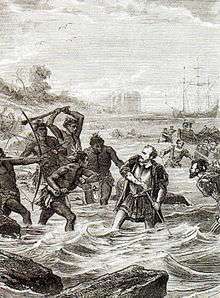
After several weeks in the Philippines, Magellan had converted as many as 2,200 locals to Christianity, including Rajah Humabon of Cebu and most leaders of the islands around Cebu.[27] However, Lapulapu, the leader of Mactan,[28] resisted conversion.[29][30] In order to gain the trust of Rajah Humabon,[31][32] Magellan sailed to Mactan with a small force on the morning of 27 April 1521. During the resulting battle against Lapulapu's troops, Magellan was struck by a bamboo spear, and later surrounded and finished off with other weapons.[33]
Antonio Pigafetta and Ginés de Mafra provided written documents of the events culminating in Magellan's death:
When morning came forty-nine of us leaped into the water up to our thighs, and walked through water for more than two crossbow flights before we could reach the shore. The boats could not approach nearer because of certain rocks in the water. The other eleven men remained behind to guard the boats. When we reached land, those men had formed in three divisions to the number of more than one thousand five hundred persons. When they saw us, they charged down upon us with exceeding loud cries ... The musketeers and crossbowmen shot from a distance for about a half-hour, but uselessly; for the shots only passed through the shields ... Recognizing the captain, so many turned upon him that they knocked his helmet off his head twice ... An Indian hurled a bamboo spear into the captain's face, but the latter immediately killed him with his lance, which he left in the Indian's body. Then, trying to lay hand on sword, he could draw it out but halfway, because he had been wounded in the arm with a bamboo spear. When the natives saw that, they all hurled themselves upon him. One of them wounded him on the left leg with a large cutlass, which resembles a scimitar, only being larger. That caused the captain to fall face downward, when immediately they rushed upon him with iron and bamboo spears and with their cutlasses, until they killed our mirror, our light, our comfort, and our true guide.
Nothing of Magellan's body survived, that afternoon the grieving rajah-king, hoping to recover his remains, offered Mactan's victorious chief a handsome ransom of copper and iron for them but Datu Lapulapu refused. He intended to keep the body as a war trophy. Since his wife and child died in Seville before any member of the expedition could return to Spain, it seemed that every evidence of Ferdinand Magellan's existence had vanished from the earth.
— Ginés de Mafra[34]
Reputation following circumnavigation
In the immediate aftermath of the circumnavigation, few celebrated Magellan for his accomplishments, and he was widely discredited and reviled in Spain and his native Portugal.[35][36] The Portuguese regarded Magellan as a traitor for having sailed for Spain. In Spain, Magellan's reputation suffered due to the largely unflattering accounts of his actions given by the survivors of the expedition.
The first news of the expedition came from the crew of the San Antonio, led by Estêvão Gomes, which deserted the fleet in the Strait of Magellan and returned to Seville 6 May 1521. The deserters were put on trial, but eventually exonerated after producing a distorted version of the mutiny at Saint Julian, and depicting Magellan as disloyal to the king. The expedition was assumed to have perished.[37] The Casa de Contratación withheld Magellan's salary from his wife, Beatriz "considering the outcome of the voyage", and she was placed under house arrest with their young son on the orders of Archbishop Fonseca.[38]
The 18 survivors who eventually returned aboard the Victoria in September 1522 were also largely unfavourable to Magellan. Many, including the captain, Juan Sebastián Elcano, had participated in the mutiny at Saint Julian. On the ship's return, Charles summoned Elcano to Valladolid, inviting him to bring two guests. He brought sailors Francisco Albo and Hernándo de Bustamante, pointedly not including Antonio Pigafetta, the expedition's chronicler. Under questioning by Valladolid's mayor, the men claimed that Magellan refused to follow the king's orders (and gave this as the cause for the mutiny at Saint Julian), and that he unfairly favoured his relatives among the crew, and disfavoured the Spanish captains.[39]
One of the few survivors loyal to Magellan was Antonio Pigafetta. Though not invited to testify with Elcano, Pigafetta made his own way to Valladolid and presented Charles with a hand-written copy of his notes from the journey. He would later travel through Europe giving copies to other royals including John III of Portugal, Francis I of France, and Philippe Villiers de L'Isle-Adam. After returning to his home of Venice, Pigafetta published his diary (as Relazione del primo viaggio intorno al mondo) around 1524. Scholars have come to view Pigafetta's diary as the most thorough and reliable account of the circumnavigation, and its publication helped to eventually counter the misinformation spread by Elcano and the other surviving mutineers.[40] In an often-cited passage following his description of Magellan's death in the Battle of Mactan, Pigafetta eulogizes the captain-general:
Magellan's main virtues were courage and perseverance, in even the most difficult situations; for example he bore hunger and fatigue better than all the rest of us. He was a magnificent practical seaman, who understood navigation better than all his pilots. The best proof of his genius is that he circumnavigated the world, none having preceded him.[41]
Legacy
Magellan has come to be renowned for his navigational skill and tenacity. The first circumnavigation has been called "the greatest sea voyage in the Age of Discovery",[42] and even "the most important maritime voyage ever undertaken".[43] Appreciation of Magellan's accomplishments may have been enhanced over time by the failure of subsequent expeditions which attempted to retrace his route, beginning with the Loaísa expedition in 1525 (which featured Juan Sebastián Elcano as second-in-command).[44] The next expedition to successfully complete a circumnavigation, led by Francis Drake, would not occur until 1580, 58 years after the return of the Victoria.[45]
Magellan named the Pacific Ocean (which was also often called the Sea of Magellan in his honor until the eighteenth century[46]), and lends his name to the Strait of Magellan. His name has also since been applied to a variety of other entities, including the Magellanic Clouds (two dwarf galaxies visible in the night sky of the southern hemisphere), Project Magellan (a Cold-War era US Navy project to circumnavigate the world by submarine), and NASA's Magellan spacecraft.
Quincentenary
Commemorations of the circumnavigation include:
- Exhibition entitled "The Longest Journey: the first circumnavigation" was opened at the General Archive of the Indies in Seville by the King and Queen of Spain. It is scheduled to transfer to the San Telmo Museum in San Sebastian.[47]
- Exhibition entitled Pigafetta: cronista de la primera vuelta al mundo Magallanes Elcano opened at the library of the Spanish Agency for International Development Cooperation in Madrid. It gave prominence to Pigafetta, the chronicler of the expedition.[48]
See also
References
- "Magellan". Collins English Dictionary. Retrieved 8 October 2019.
- "Magellan". Random House Webster's Unabridged Dictionary. Retrieved 8 October 2019.
- Hartig, Otto (1 October 1910). "Ferdinand Magellan". Catholic Encyclopedia. 9. New York: Robert Appleton Company. Retrieved 31 October 2010 – via NewAdvent.org.
- Miller, Gordon (2011). Voyages: To the New World and Beyond (1st ed.). University of Washington Press. p. 30. ISBN 978-0-295-99115-3.
- Dutch, Steve (21 May 1997). "Circumnavigations of the Globe to 1800". University of Wisconsin-Green Bay. Archived from the original on 23 October 2014. Retrieved 11 October 2014.
- Bergreen 2003, p. 17.
- Hartig, Otto (1913). . In Herbermann, Charles (ed.). Catholic Encyclopedia. New York: Robert Appleton Company.
- Ocampo 2019.
-

- James A. Patrick, Renaissance and Reformation, p. 787, Marshall Cavendish, 2007, ISBN 0-7614-7650-4
- William J. Bernstein, A Splendid Exchange: How Trade Shaped the World, pp. 183–185, Grove Press, 2009, ISBN 0-8021-4416-0
- Zweig, Stefan, "Conqueror of the Seas – The Story of Magellan", pp. 44–45, Read Books, 2007, ISBN 1-4067-6006-4
- Joyner 1992, pp. 42-43.
- Joyner 1992, p. 50.
- Zweig, Stefan, "Conqueror of the Seas – The Story of Magellan", p. 51, Read Books, 2007, ISBN 1-4067-6006-4
- R.A. Donkin, "Between East and West: The Moluccas and the Traffic in Spices up to the Arrival of Europeans", p. 29, Volume 248 of Memoirs of the American Philosophical Society, Diane Publishing, 2003 ISBN 0-87169-248-1
- Mervyn D. Kaufman (2004), Ferdinand Magellan, Capstone Press, pp. 13, ISBN 978-0-7368-2487-3
- "Beatriz Barbosa, 1495". Geneall.net.
- Noronha 1921.
- Nancy Smiler Levinson (2001), Magellan and the First Voyage Around the World, Houghton Mifflin Harcourt, p. 39, ISBN 978-0-395-98773-5, retrieved 31 July 2010,
Personnel records are imprecise. The most accepted total number is 270.
- Bergreen 2003, p. 61.
- Cameron 1974, p. 145.
- Bergreen 2003, p. 215.
- George Bryan Souza, Jeffrey S. Turley (2016). The Boxer Codex Transcription and Translation of an Illustrated Late Sixteenth-Century Spanish Manuscript Concerning the Geography, History and Ethnography of the Pacific, South-East and East Asia. Brill. p. 303. ISBN 978-90-04-29273-4. OCLC 932684337.
- Bergreen 2003, pp. 224-231.
- Cameron 1974, p. 209.
- Bergreen 2003, p. 271.
- ABS-CBN News (1 May 2019). "It's Lapulapu: Gov't committee weighs in on correct spelling of Filipino hero's name". ABS-CBN News. ABS-CBN Corporation. Retrieved 22 November 2019.
- David, Hawthorne (1964). Ferdinand Magellan. Doubleday & Company, Inc.
- "Battle of Mactan Marks Start of Organized Filipino Resistance Vs. Foreign Aggression". Retrieved 9 April 2009.
- Ocampo, Ambeth (13 November 2019). "Lapu-Lapu, Magellan and blind patriotism". Inquirer.net. Retrieved 22 November 2019.
- Mojarro, Jorge (10 November 2019). "[OPINION] The anger toward the 'Elcano & Magellan' film is unjustified". Rappler. Rappler Inc. Retrieved 22 November 2019.
- Pigafetta, Antonio. Magellan's Voyage Around the World (1906 ed.). tr. James Alexander Robertson
- Manchester, William (1993). A World Lit Only by Fire. Little, Brown and Company. ISBN 978-0-316-54556-3.
- Bergreen 2003, p. 406.
- Cameron 1974, p. 210.
- Bergreen 2003, p. 299.
- Bergreen 2003, p. 305.
- Bergreen 2003, pp. 399-402.
- Bergreen 2003, pp. 403-405.
- Cameron 1974, p. 215.
- Bergreen 2003, p. 414.
- Bergreen 2003, p. 2.
- Bergreen 2003, p. 412.
- Bergreen 2003, p. 413.
- Camino, Mercedes Maroto. Producing the Pacific: Maps and Narratives of Spanish Exploration (1567–1606), p. 76. 2005.
- "King and Queen of Spain open commemorative exhibition on first circumnavigation by Magellan and Elcano". 2019. Retrieved 22 October 2019.
- "Pigafetta: cronista de la primera vuelta al mundo Magallanes Elcano".
Sources
- Beaglehole, J.C. (1966), The Exploration of the Pacific, London: Adam & Charles Black, OCLC 253002380
- Castro, Xavier de; Hamon, Jocelynn; Thomaz, Luis Filipe de Castro (2007). Le voyage de Magellan (1519–1522). La relation d'Antonio Pigafetta & autres témoignages. Paris: Chandeigne, coll. "Magellane". ISBN 978-2-915540-32-1.
- Cliffe, Edward (1885). Hakluyt, Richard (ed.). "The voyage of M. John Winter into the South sea by the Streight of Magellan, in consort with M. Francis Drake, begun in the yeere 1577". The principal navigations, voyages, traffiques and discoveries of the English nation. Edinburgh: E. & G. Goldsmid.
- Drake, Francis (1628), The world encompassed by Sir Francis Drake: being his next voyage to that to Nombre de Dios Elibron, Classics series, Issue 16 of Works issued by the Hakluyt Society, Adamant Media Corporation, ISBN 978-1-4021-9567-9
- Hogan, C. Michael (2008). N. Stromberg (ed.). Magellanic Penguin. GlobalTwitcher.com. Archived from the original on 23 August 2011.
- Noronha, Dom José Manoel de (1921). Imprensa da Universidade (ed.). Algumas Observações sobre a Naturalidade e a Família de Fernão de Magalhães (in Portuguese). Coimbra: Biblioteca Genealogica de Lisboa. Archived from the original on 7 March 2010.CS1 maint: ref=harv (link)
- Stefoff, Rebecca (1990), Ferdinand Magellan and the Discovery of the World Ocean, Chelsea House Publishers, ISBN 978-0-7910-1291-8
- Suárez, Thomas (1999). Early mapping of Southeast Asia. Tuttle Publishing. ISBN 978-962-593-470-9.CS1 maint: ref=harv (link)
Online sources
- Ocampo, Ambeth (5 July 2019), "Magellan's last will and testament", INQUIRER.net, INQUIRER.net, retrieved 5 July 2019
- Swenson, Tait M. (2005). "First Circumnavigation of the Globe by Magellan 1519–1522". The Web Chronology project. Retrieved 14 March 2006.
Further reading
Primary sources
- Pigafetta, Antonio (1906), Magellan's Voyage around the World, Arthur A. ClarkCS1 maint: ref=harv (link) (orig. Primer viaje en torno del globo Retrieved on 2009-04-08)
- Magellan (Francis Guillemard, Antonio Pigafetta, Francisco Albo, Gaspar Correa) [2008] Viartis ISBN 978-1-906421-00-7
- Maximilianus Transylvanus, De Moluccis insulis, 1523, 1542
- Nowell, Charles E. ed. (1962), Magellan's Voyage around the World: Three Contemporary Accounts, Evanston: NU PressCS1 maint: extra text: authors list (link)
- The First Voyage Round the World, by Magellan, full text, English translation by Lord Stanley of Alderley, London: Hakluyt, [1874] – six contemporary accounts of his voyage
Secondary sources
- Bergreen, Laurence (2003), Over the Edge of the World: Magellan's Terrifying Circumnavigation of the Globe, William Morrow, ISBN 978-0-06-093638-9, lay summary
- Guillemard, Francis Henry Hill (1890), The life of Ferdinand Magellan, and the first circumnavigation of the globe, 1480–1521, G. Philip, retrieved 8 April 2009
- Hildebrand, Arthur Sturges (1924), Magellan, New York: Harcourt, Brace & Co, ISBN 978-1-4179-1413-5
- Joyner, Tim (1992), Magellan, Camden, Me.: International Marine Publishing, ISBN 978-0-07-033128-0
- Nunn, George E. (1932), The Columbus and Magellan Concepts of South American Geography
- Parr, Charles M. (1953), So Noble a Captain: The Life and Times of Ferdinand Magellan, New York: Crowell, ISBN 978-0-8371-8521-7
- Parry, J.H. (1979), The Discovery of South America, New York: Taplinger
- Parry, J.H. (1981), The Discovery of the Sea, Berkeley: University of California Press, ISBN 978-0-520-04236-0
- Parry, J.H. (1970), The Spanish Seaborne Empire, New York: Knopf, ISBN 978-0-520-07140-7
- Pérez-Mallaína, Pablo E. (1998), Spain's Men of the Sea: Daily Life on the Indies Fleets in the Sixteenth Century, trans. Carla Rahn Phillips, Baltimore: Johns Hopkins University Press, ISBN 978-0-8018-5746-1, lay summary
- Roditi, Edouard (1972), Magellan of the Pacific, London: Faber & Faber, ISBN 978-0-571-08945-1
- Schurz, William L. (May 1922), "The Spanish Lake", Hispanic American Historical Review, 5 (2): 181–194, doi:10.2307/2506024, JSTOR 2506024.
- Thatcher, Oliver J. ed. (1907), "Vol. V: 9th to 16th Centuries", The Library of Original Sources, University Research Extension Co, pp. 41–57, retrieved 8 April 2009CS1 maint: extra text: authors list (link)
- Wilford, John Noble (2000), The Mapmakers, New York: Knopf, ISBN 978-0-375-70850-3, lay summary
- Zweig, Stefan (2007), Conqueror of the Seas – The Story of Magellan, Read Books, ISBN 978-1-4067-6006-4
- Cameron, Ian (1974). Magellan and the first circumnavigation of the world. London: Weidenfeld & Nicolson. ISBN 029776568X. OCLC 842695.CS1 maint: ref=harv (link)
External links
| Wikimedia Commons has media related to Ferdinand Magellan. |
| Wikiquote has quotations related to: Ferdinand Magellan |
